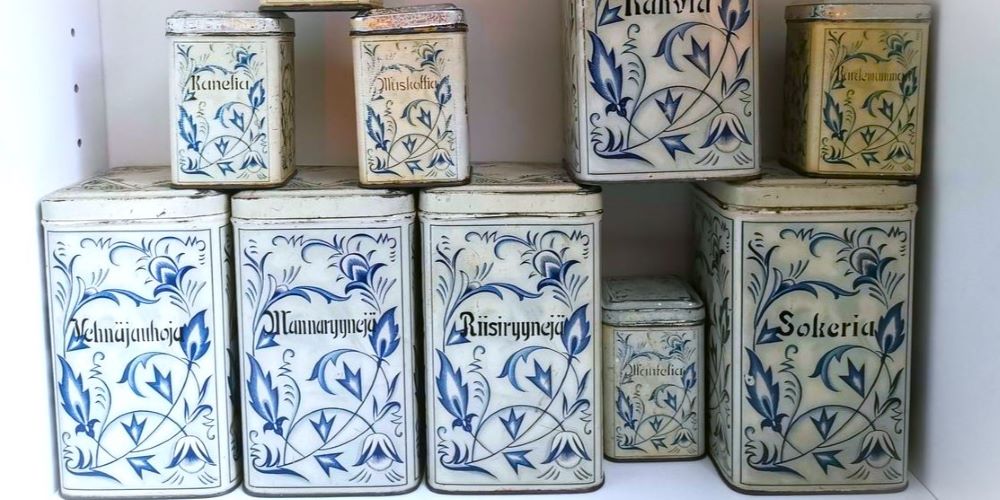How to Store and Clean Old Tin Cans

Value of Vintage Tin Cans
All cans have their takers. Older cans are sought-after collectibles, sometimes fetching significant sums of money. Even newer cans can be sold for small amounts, and at the very least, many people will gladly take them for free, especially for crafts. It’s not worth throwing away even cans in poor condition since older cans are becoming rare, and even dented, rusty, or torn-label cans have value today. And even if it’s a newer can, it can still be used, for example, as a flower pot. Remember the old saying: one person’s trash is another’s treasure!
Keeping Parts Together – How to restore Vintage Tin Cans
Often, cans come in two separate parts (the base & a metal or plastic lid), which naturally should be kept together. A complete can is more valuable (especially if it’s entirely metal!), and the lid keeps the can clean and dust-free inside. In the 1960s to 1980s, coffee was often packed in round, plastic-lidded tins in Finland. Although lids from different manufacturers might fit other tins, it’s best to keep the can & lid pairs together when possible, as a matching pair is always more desirable and authentic.
Preparing for Storage or Sale
Before storage or sale, empty the can of any contents, especially if it’s organic matter that can spoil and mold. However, do not open unopened packages, as unopened cans can sometimes fetch higher prices due to their rarity.
Cleaning Recommendations
If the can is in good and clean condition, it’s usually best not to wash it. Wiping off the dust is generally sufficient. Do not attempt to remove ingrained/dry rust, dirt, paint, etc., mechanically or chemically, as this can easily damage the can. Small dents can be carefully straightened by pressing the metal.
Handling Labels and Stickers
Do not try to remove stickers, writing, etc., from the can unless they are clearly unrelated. For instance, back in the day, the price of loose candy might have been written on paper-labeled candy jars, or coffee cans might have manufacturer-provided stickers to mark the cans for other uses. These additions have cultural and economic historical value and generally do not affect the can’s monetary value either way.
How to Clean Decorative Tin/Metal Cans
Only painted cans should be cleaned with water. Labels, stickers, and other papers will come off and get ruined if washed with water. Clean plastic and wooden parts the same way as metal parts. If the can is so dirty that you want to wash it, always use cold water without detergents. Warm water and detergents can damage the can’s paint. Many old cans have been ruined by hot water and dish soap.
Do not use a dish brush or other cleaning tools that can scratch the paint. Wipe the can by hand or at most with wet toilet paper. If possible, avoid soaking the entire can in water. Instead, try to wet only the areas with dirt.
Drying and Storing
Immediately after washing, dry the can thoroughly (but gently!) to prevent water from settling in and causing rust. Pay special attention to the seams of the can. Do not dry cans with hot air (e.g., a hairdryer), as heat can damage the paint.
Preventing Mold and Rust
Store cans in a dry and cool place to prevent mold and rust. Protect cans from light, especially direct sunlight, which can damage the labels and paint. Fully metal, painted cans without stickers, labels, or other paper can be protected by wiping their surface gently with petroleum jelly. This leaves the cans looking shiny and protects them from rust and mold. You can reapply the oil occasionally by wiping on a new layer. The downside is that it leaves the can’s surface slightly sticky.
Handling and Use
Store cans separately from other surfaces (walls, other cans, etc.), as cans are prone to scratching and denting. Even if the cans are used, handle them minimally, as scratches, dents, broken hinges, etc., cannot be easily fixed later. Even the mechanical friction and oils from human skin can damage the surfaces of the cans over time!